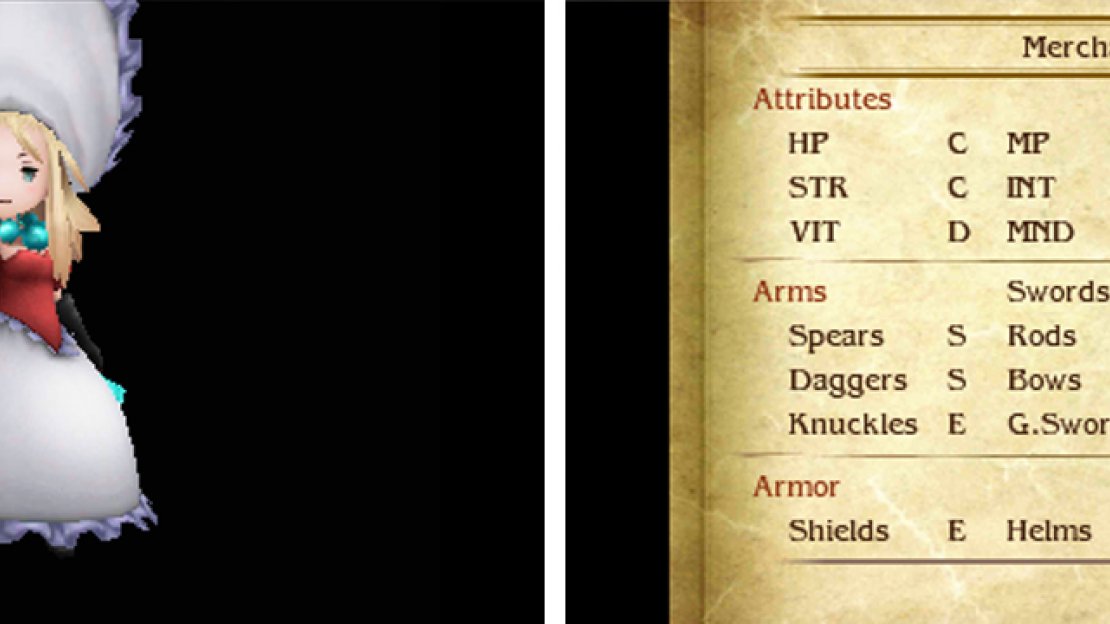The Merchant is a middle of the road job, who’s primary role is to support allies and make (and spend) money. Its stats float between above average and mediocre and it’s adept at wielding spears, daggers and staves. Not a job you should be managing full-time, but can be useful on the side.
More Money is the key reason to become a Merchant, boosting the pg earned after battle by 50%. Around the time you acquire Merchant, pg isn’t exactly growing on trees, so a way to acquire more is certainly welcome. The extra money can be used to buy items or pay for Merchant abilities.
Specialty: More Money¶
Earn 1.5 times more money after a battle. Stacks with items that boost earnings, but does not stack for multiple characters with this ability.
This alone makes Merchant a worthwhile job to train. Later, you can combine it with the Golden Egg to obtain 3 times the money.
Level 1: Pay to Play¶
| Type | Cost |
|---|---|
| Command | None |
Spend (the user’s Level x 50) pg to increase a character’s critical rate by 300% for 4 turns (up to a maixmum of 500%).
Critical hits deal double damage, so if you’ve cash to spare, this is a decent way of boosting your physical damage output. For convincing results, use it with katanas or other weapons with high critical rate.
Level 2: White Knight¶
| Type | Cost |
|---|---|
| Support | 1 slot |
The highest HP ally sustains a single-target physical attack for the user when the user’s HP is below 20%.
Until you get the Knight’s Protect Ally, this is great for protecting your Merchant or healer. Can be abused against foes who only use single-target attacks.
Level 3: Pharmacy¶
| Type | Cost |
|---|---|
| Command | None |
Spend pg to purchase a recovery item and immediately use it on a character.
You can buy Potions, Hi-Potions, X-Potions, Ethers, Turbo Ethers, Phoenix Downs and Remedies. Perfect if you’ve ran out of items in the middle of a dungeon. If you have the Patissier’s Items for All, these items will affect all party members too.
Level 4: Salesman¶
| Type | Cost |
|---|---|
| Command | None |
Make an enemy buy a consumable item for 2.4 times the normal selling price. Chance of success depends on the item.
Selling an item at a shop gives you 25% of the item’s original value; with Salesman, you’re effectively getting 60% of the item back. Which isn’t bad, especially if you obtained the item for free (from a chest or enemy drop).
Level 5: More Money¶
| Type | Cost |
|---|---|
| Support | 1 slot |
Earn 1.5 times more money after a battle. Stacks with items that boost earnings, but does not stack for multiple characters with this ability.
A slightly expensive ability, but now you can earn additional pg without being in the statistically unspectacular Merchant job.
Level 6: Hedge Risk¶
| Type | Cost |
|---|---|
| Command | None |
The user receives half damage for 5 turns by spending money equal to half the damage.
This is a novel–but potentially very expensive–way of reducing damage and allowing characters to survive hits they normally couldn’t sustain. In most cases, you should save your money and boost your party’s defences instead.
Level 7: Takeover¶
| Type | Cost |
|---|---|
| Command | None |
Spend (the user’s Level x 50) pg to damage one enemy an amount equal to the pg spent.
Normally, you can achieve a maximum of 4950 damage by spending 4950 pg. Under most circumstances, it’s not really needed, but can be useful for bypassing Default and/or the enemy’s defences.
Level 8: BP Drink¶
| Type | Cost |
|---|---|
| Command | None |
Spend pg to buy a BP recovery item and immediately use it on a character. 1,000 pg grants 1 BP, 10,000 pg grants 2 BP and 100,000 pg grants 3 BP.
If money’s not an issue, this is a quick way of gaining additional BP. Unfortunately, it doesn’t stack with Items for All, although it would be game-breaking if it did. There are other and cheaper ways to amass BP though, like BP Recovery and My Hero.
Level 9: Big Pharma¶
| Type | Cost |
|---|---|
| Command | None |
Restore an enemy’s HP and receive pg equal to the HP recovered. The pg obtained is capped at 99,999 pg per battle (and the cap resets during consecutive battles). The healing power is equivalent to Cure.
With enough effort and the right setup, you can rake in a fair amount of pg by leaving your game on Auto-Battle for a while. Unfortunately, the pg you can acquire is capped unlike in Bravely Default, so you won’t be making millions anymore.
Level 10: Payoff¶
| Type | Cost |
|---|---|
| Command | None |
Spend money to buy off the enemy and immediately end the battle. You still acquire pg, experience, JP and items as per normal.
This works , but is probably only worth trying once for laughs and giggles. No enemy cannot be defeated with a little effort and bosses require a gazillion amount of pg to buy off.
Level 11: Insurance¶
| Type | Cost |
|---|---|
| Support | 2 slots |
Upon taking damage from enemy attacks, receive pg equal to half the damage received. The pg obtained is capped at 99,999 pg per battle (and the cap resets during consecutive battles).
A passive and pretty efficient way of earning more pg, especially towards late-game when enemies hit harder. Assuming you let them hit you in the first place!

No Comments